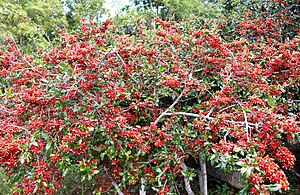Saw-leaved nailberry
| Saw-leaved nailberry | ||||||||||||
|---|---|---|---|---|---|---|---|---|---|---|---|---|

Saw-leaved nailberry ( Ochna serrulata ) |
||||||||||||
| Systematics | ||||||||||||
|
||||||||||||
| Scientific name | ||||||||||||
| Ochna serrulata | ||||||||||||
| ( Hochst. ) Walp. |
The saw-leaved nailberry ( Ochna serrulata ) is a species of nailberry ( Ochna ) in the nailberry family (Ochnaceae). In English it also bears the funny looking trivial name "Mickey Mouse plant", which is explained by the appearance of the ripe black berries in the middle of the red sepals.
description
Appearance and foliage leaf
The saw-leaved nailberry grows as a shrub or, more rarely, a small tree and often only reaches heights of 1 to 2 meters, more rarely up to about 6 meters. The slender branches have a smooth, brown bark that is covered with small, light-colored, raised points. The leaves are 1.3 to 5 cm long and narrow, elliptical in shape with a rounded base and sometimes narrowed in the upper area with blunt or pointed ends. The leaf margin is serrated with teeth pointing upwards. The median and lateral nerves are noticeable on the upper side of the leaf. During the shoot in spring, the leaves are a beautiful pink-bronze color and later turn glossy green.
blossom
The flowering time is in spring, in the home in September to November, as this belongs to the southern hemisphere . The fragrant, hermaphrodite, radial symmetry flowers have a diameter of about 2 cm and have a double flower envelope . The yellow petals are only durable for a short time, but are very beautiful jewelry during this time. There are many stamens present. The pollination is carried out mainly by bees and butterflies.
fruit
Usually there are five to six fruits together. The more or less spherical, berry-like drupes are initially green and when they ripen in early summer (November) turn glossy black. The bright red sepals enlarge before the fruit is ripe . Since the sepals stay on the shrub until late summer (January to February), the whole shrub appears conspicuously red for several months. The ripe, black fruits are eaten by birds.
Occurrence
The home of the saw-leaved nail berry is in subtropical southern Africa , more precisely in eastern South Africa and in Swaziland . It thrives along the subtropical east coast at altitudes between 0 and 1800 meters. It often forms the shrub layer in the forests.
In Oceania and Hawaii it is a neophyte.
The sawblade nail berry tolerates light frosts, but is not winter hardy in Central Europe .
swell
- Giles Mbambezeli & Alice Notten: Ochna serrulata at plantzafrica.com of the Kirstenbosch National Botanical Garden , 2002. (Section description and occurrence)


